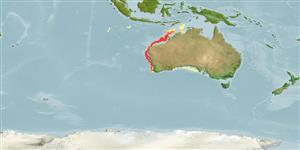Elasmobranquios (tiburones y rayas) (sharks and rays) >
Carcharhiniformes (Ground sharks) >
Triakidae (Houndsharks) > Triakinae
Etymology: Mustelus: Latin for weasel, an ancient name for sharks, possibly referring to the pointed snouts, swift movements and/or rapacious feeding behavior of smaller predatory sharks [strictly not tautonymous with Squalus mustelus Linnaeus 1758 since type was designated by the ICZN]. (See ETYFish); stevensi: In honor of John Stevens (b. 1947), Senior Principal Research Scientist, CSIRO Marine and Atmospheric Research (Australia), who has “dedicated a lifetime to researching sharks around the world, and who has contributed greatly to our knowledge of sharks and rays in Australia”. (See ETYFish).
More on authors: White & Last.
Environment: milieu / climate zone / depth range / distribution range
Ecología
marino bentopelágico; rango de profundidad 69 - 735 m (Ref. 124465). Tropical
Eastern Indian Ocean: tropical, from northwest Australia to southern Indonesia and the Andaman Sea.
Length at first maturity / Tamaño / Peso / Age
Maturity: Lm 75.1, range 58 - 91.9 cm
Max length : 128 cm TL macho / no sexado; (Ref. 124465); 103.4 cm TL (female)
Short description
Morfología | Morfometría
This moderately large species is disinguished by the following characters: palatine processes of the
palatoquadrates not subdivided at the symphysis; pre-second dorsal length 58.1-61.4% TL; upper labial furrows are longer than lower furrows, upper ones 1.7-2.3% TL and 1.3-1.7 times lowers; buccopharyngeal denticles cover entire tongue and roof of mouth; reproductive mode aplacental viviparity; adults are without any hypercalcification of skeletal elements; dorsal fins moderately large and upright, first dorsal-fin anterior margin 13.0-15.7% TL, height 8.5-10.3% TL; claspers of adults are moderately long, inner length 8.1-11.2% TL; teeth in about 72/75 files; precaudal vertebral centra 75-91, monospondylous centra 33-41; small white spots usually present on the dorsal surfaces of body, including along lateral line; dorsal fins often with dark apical margins; caudal-fin terminal lobe white tipped (Ref. 124465).
Recorded litter size litter sizes of 5-17 pups with size at birth likely to be around 28.0 cm TL (Ref. 124465).
Life cycle and mating behavior
Madurez | Reproducción | Puesta | Huevos | Fecundidad | Larva
White, W.T., S. Arunrugstichai and G.J.P. Naylor, 2021. Revision of the genus Mustelus (Carcharhiniformes: Triakidae) in the northern Indian Ocean, with description of a new species and a discussion on the validity of M. walkeri and M. ravidus. Mar. Biodiversity 51(42):1-24. (Ref. 124465)
IUCN Red List Status (Ref. 130435)
Threat to humans
Harmless
Human uses
Más información
Age/SizeCrecimientoLength-weightLength-lengthLength-frequenciesMorfometríaMorfologíaLarvaDinámica larvariaReclutamientoAbundanciaBRUVS
ReferenciasAcuiculturaPerfil de acuiculturaRazasGenéticaElectrophoresesheritabilidadEnfermedadesProcesamientoNutrientsMass conversion
ColaboradoresImágenesStamps, Coins Misc.SonidosCiguateraVelocidadTipo de nataciónSuperficie branquialOtolitosCerebrosVisión
Herramientas
Special reports
Download XML
Fuentes de Internet
Estimates based on models
Preferred temperature (Ref.
123201): 13.5 - 20.4, mean 16.5 °C (based on 27 cells).
Phylogenetic diversity index (Ref.
82804): PD
50 = 0.5000 [Uniqueness, from 0.5 = low to 2.0 = high].
Bayesian length-weight: a=0.00224 (0.00105 - 0.00478), b=3.14 (2.97 - 3.31), in cm total length, based on LWR estimates for this Genus-body shape (Ref.
93245).
Nivel trófico (Ref.
69278): 3.7 ±0.4 se; based on size and trophs of closest relatives
Resiliencia (Ref.
120179): Medio, población duplicada en un tiempo mínimo de 1.4-4.4 años (Preliminary K or Fecundity.).
Fishing Vulnerability (Ref.
59153): Very high vulnerability (77 of 100).
